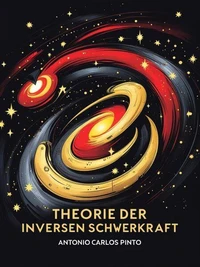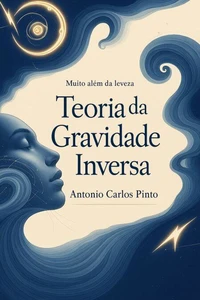Nouveauté
Theory of Inverse Gravity. Antimatter/Antigravity, #1
Par :Formats :
Disponible dans votre compte client Decitre ou Furet du Nord dès validation de votre commande. Le format ePub protégé est :
- Compatible avec une lecture sur My Vivlio (smartphone, tablette, ordinateur)
- Compatible avec une lecture sur liseuses Vivlio
- Pour les liseuses autres que Vivlio, vous devez utiliser le logiciel Adobe Digital Edition. Non compatible avec la lecture sur les liseuses Kindle, Remarkable et Sony
- Non compatible avec un achat hors France métropolitaine
 , qui est-ce ?
, qui est-ce ?Notre partenaire de plateforme de lecture numérique où vous retrouverez l'ensemble de vos ebooks gratuitement
Pour en savoir plus sur nos ebooks, consultez notre aide en ligne ici
- FormatePub
- ISBN8231072927
- EAN9798231072927
- Date de parution06/07/2025
- Protection num.Adobe DRM
- Infos supplémentairesepub
- ÉditeurWalzone Press
Résumé
The Theory of Inverse Gravity, proposed in this book by Antonio Carlos Pinto, challenges Einstein's paradigm of General Relativity (GR) by introducing a fifth fundamental force: a repulsive gravity that acts selectively on radiant energy, such as photons, plasma and polaritons, in opposition to the gravitational attraction of matter. This work presents a reassessment of the foundations of cosmology and quantum physics, proposing that the dual interaction between attraction and repulsion can explain observational phenomena neglected by GR, such as the rise of flames, the deceleration of light in supersolid states and the accelerated expansion of the universe.
Formalized by the modified field equation ( G_{mu u} = frac{8 pi G}{c^4} (T_{mu u}^{ ext{mat}} - kappa T_{mu u}^{ ext{rad}}) ), the theory suggests that radiant energy curves spacetime in the opposite way to matter, with the parameter ( kappa ) quantifying this repulsion. The main goal is to propose an alternative model for the origin of the universe, the Primordial Repulsive Explosion (PRE), which eliminates the Big Bang singularity and attributes the initial expansion to inverse gravity, potentially eliminating the need for dark energy (Chapter 35).
The theory also explores the manipulation of the speed of light in material media, as demonstrated by experiments by Lene Hau (1999) and TU Darmstadt (2013), suggesting that gravitational repulsion stabilizes quantum states such as supersolid light (Chapter 35-B). In addition, it analyzes the confinement of plasma in the EAST reactor, China's "Artificial Sun", proposing tests with LIDAR to detect angular deviations consistent with theory (Chapter 32).
Inspired by controversial experiments by Eugene Podkletnov (2023) and ideas by Roger Penrose (2020) and Dragan Hajdukovic (2011), the work raises profound questions: does antimatter exhibit suppress antigravity? Does dark matter arise from primordial white holes? Is dark energy an illusion of inverse gravity? Methodologically, the theory proposes testable experiments, including measurements at EAST, analyzes of the cosmic microwave background (CMB) by the Simons Observatory (2023), and studies of polaritons, aiming to validate gravitational repulsion.
The expected results include a reinterpretation of cosmology, unifying quantum physics and gravitation, and challenging the standard model. Its relevance lies in offering a theoretical framework that encourages the scientific community to explore gaps in GR, such as the singularity and the nature of dark energy, contributing to a revolution in theoretical physics. This work, completed on July 6, 2025, is a manifesto for nonconformists who seek answers beyond the current limits of knowledge.
Formalized by the modified field equation ( G_{mu u} = frac{8 pi G}{c^4} (T_{mu u}^{ ext{mat}} - kappa T_{mu u}^{ ext{rad}}) ), the theory suggests that radiant energy curves spacetime in the opposite way to matter, with the parameter ( kappa ) quantifying this repulsion. The main goal is to propose an alternative model for the origin of the universe, the Primordial Repulsive Explosion (PRE), which eliminates the Big Bang singularity and attributes the initial expansion to inverse gravity, potentially eliminating the need for dark energy (Chapter 35).
The theory also explores the manipulation of the speed of light in material media, as demonstrated by experiments by Lene Hau (1999) and TU Darmstadt (2013), suggesting that gravitational repulsion stabilizes quantum states such as supersolid light (Chapter 35-B). In addition, it analyzes the confinement of plasma in the EAST reactor, China's "Artificial Sun", proposing tests with LIDAR to detect angular deviations consistent with theory (Chapter 32).
Inspired by controversial experiments by Eugene Podkletnov (2023) and ideas by Roger Penrose (2020) and Dragan Hajdukovic (2011), the work raises profound questions: does antimatter exhibit suppress antigravity? Does dark matter arise from primordial white holes? Is dark energy an illusion of inverse gravity? Methodologically, the theory proposes testable experiments, including measurements at EAST, analyzes of the cosmic microwave background (CMB) by the Simons Observatory (2023), and studies of polaritons, aiming to validate gravitational repulsion.
The expected results include a reinterpretation of cosmology, unifying quantum physics and gravitation, and challenging the standard model. Its relevance lies in offering a theoretical framework that encourages the scientific community to explore gaps in GR, such as the singularity and the nature of dark energy, contributing to a revolution in theoretical physics. This work, completed on July 6, 2025, is a manifesto for nonconformists who seek answers beyond the current limits of knowledge.
The Theory of Inverse Gravity, proposed in this book by Antonio Carlos Pinto, challenges Einstein's paradigm of General Relativity (GR) by introducing a fifth fundamental force: a repulsive gravity that acts selectively on radiant energy, such as photons, plasma and polaritons, in opposition to the gravitational attraction of matter. This work presents a reassessment of the foundations of cosmology and quantum physics, proposing that the dual interaction between attraction and repulsion can explain observational phenomena neglected by GR, such as the rise of flames, the deceleration of light in supersolid states and the accelerated expansion of the universe.
Formalized by the modified field equation ( G_{mu u} = frac{8 pi G}{c^4} (T_{mu u}^{ ext{mat}} - kappa T_{mu u}^{ ext{rad}}) ), the theory suggests that radiant energy curves spacetime in the opposite way to matter, with the parameter ( kappa ) quantifying this repulsion. The main goal is to propose an alternative model for the origin of the universe, the Primordial Repulsive Explosion (PRE), which eliminates the Big Bang singularity and attributes the initial expansion to inverse gravity, potentially eliminating the need for dark energy (Chapter 35).
The theory also explores the manipulation of the speed of light in material media, as demonstrated by experiments by Lene Hau (1999) and TU Darmstadt (2013), suggesting that gravitational repulsion stabilizes quantum states such as supersolid light (Chapter 35-B). In addition, it analyzes the confinement of plasma in the EAST reactor, China's "Artificial Sun", proposing tests with LIDAR to detect angular deviations consistent with theory (Chapter 32).
Inspired by controversial experiments by Eugene Podkletnov (2023) and ideas by Roger Penrose (2020) and Dragan Hajdukovic (2011), the work raises profound questions: does antimatter exhibit suppress antigravity? Does dark matter arise from primordial white holes? Is dark energy an illusion of inverse gravity? Methodologically, the theory proposes testable experiments, including measurements at EAST, analyzes of the cosmic microwave background (CMB) by the Simons Observatory (2023), and studies of polaritons, aiming to validate gravitational repulsion.
The expected results include a reinterpretation of cosmology, unifying quantum physics and gravitation, and challenging the standard model. Its relevance lies in offering a theoretical framework that encourages the scientific community to explore gaps in GR, such as the singularity and the nature of dark energy, contributing to a revolution in theoretical physics. This work, completed on July 6, 2025, is a manifesto for nonconformists who seek answers beyond the current limits of knowledge.
Formalized by the modified field equation ( G_{mu u} = frac{8 pi G}{c^4} (T_{mu u}^{ ext{mat}} - kappa T_{mu u}^{ ext{rad}}) ), the theory suggests that radiant energy curves spacetime in the opposite way to matter, with the parameter ( kappa ) quantifying this repulsion. The main goal is to propose an alternative model for the origin of the universe, the Primordial Repulsive Explosion (PRE), which eliminates the Big Bang singularity and attributes the initial expansion to inverse gravity, potentially eliminating the need for dark energy (Chapter 35).
The theory also explores the manipulation of the speed of light in material media, as demonstrated by experiments by Lene Hau (1999) and TU Darmstadt (2013), suggesting that gravitational repulsion stabilizes quantum states such as supersolid light (Chapter 35-B). In addition, it analyzes the confinement of plasma in the EAST reactor, China's "Artificial Sun", proposing tests with LIDAR to detect angular deviations consistent with theory (Chapter 32).
Inspired by controversial experiments by Eugene Podkletnov (2023) and ideas by Roger Penrose (2020) and Dragan Hajdukovic (2011), the work raises profound questions: does antimatter exhibit suppress antigravity? Does dark matter arise from primordial white holes? Is dark energy an illusion of inverse gravity? Methodologically, the theory proposes testable experiments, including measurements at EAST, analyzes of the cosmic microwave background (CMB) by the Simons Observatory (2023), and studies of polaritons, aiming to validate gravitational repulsion.
The expected results include a reinterpretation of cosmology, unifying quantum physics and gravitation, and challenging the standard model. Its relevance lies in offering a theoretical framework that encourages the scientific community to explore gaps in GR, such as the singularity and the nature of dark energy, contributing to a revolution in theoretical physics. This work, completed on July 6, 2025, is a manifesto for nonconformists who seek answers beyond the current limits of knowledge.






















